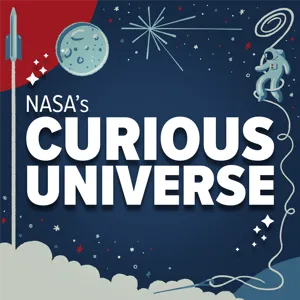Podcast Summary
New insights into the universe from the James Webb Space Telescope: The James Webb Space Telescope's first images reveal previously obscured distant galaxies through a natural lens in a galaxy cluster, revolutionizing astronomy and enabling deeper exploration of the universe, our solar system, and potential signs of life on exoplanets.
The James Webb Space Telescope, a groundbreaking NASA project decades in the making, has provided stunning new insights into the universe. The first images released from the telescope, including one of a galaxy cluster called Abell 2744, reveal distant galaxies that were previously obscured. This discovery is significant because the galaxy cluster acts as a natural lens, allowing scientists to see deeper into the universe. The Webb Telescope is revolutionizing astronomy, enabling us to explore the early life of the universe, new details about our solar system, and potential signs of life on exoplanets. Whether you're a seasoned space enthusiast or just starting your cosmic journey, the Curious Universe podcast is your go-to source for fascinating insights into our universe. So, sit back, relax, and join us as we continue to unravel the mysteries of the cosmos.
Bringing the James Webb Space Telescope to Life: A New Era of Cosmic Discoveries: The James Webb Space Telescope, with its larger primary mirror and ability to capture infrared light, revolutionizes our understanding of the universe, revealing new galaxies and opening new avenues for research.
The James Webb Space Telescope, a groundbreaking astronomical instrument, represents a significant leap forward in our understanding of the universe. Astronomers Jane Rigby and her team have been instrumental in bringing this telescope to life since its inception, recognizing its potential to build on the legacy of previous observatories and revolutionize our knowledge of the cosmos. With a primary mirror 60 times larger than its predecessor, Spitzer, Webb was designed to capture infrared light from the early universe, revealing galaxies that have been traveling billions of years to reach us. After years of planning, construction, and testing, Webb launched on Christmas day 2021 and underwent a delicate commissioning process to align its mirrors with the necessary precision. The results exceeded expectations, with images twice as sharp as promised and breathtaking discoveries. For scientists, the true beauty lies in the data Webb provides, opening new avenues for research and exploration.
Exploring the early universe with JWST: The James Webb Space Telescope is revolutionizing our understanding of the early universe by providing unprecedented insights into distant galaxies and their chemical compositions, taking us back to the Big Bang and the rapid expansion of the universe.
The James Webb Space Telescope (JWST) is revolutionizing our understanding of the early universe by providing unprecedented insights into distant galaxies and their chemical compositions. Taylor Hutchison, a postdoctoral fellow at NASA, shares her excitement about this new data, which has significantly advanced our knowledge in just one year. Before JWST, Hutchison used ground-based telescopes for spectroscopy to study early galaxies, but JWST's capabilities have surpassed her expectations. The process of looking at distant galaxies is akin to cosmic archaeology, as we're essentially looking far across the universe and far back in time. The vastness of space and the finite speed of light mean that when we see images from billions of light-years away, we're also looking billions of years back in time. This new data takes us back to the Big Bang and the rapid expansion of the universe, providing valuable insights into the mysteries of the early universe.
The universe's development and redshift: Recent discoveries from the James Webb Space Telescope challenge the assumption that black holes and galaxies formed simultaneously, revealing that black holes may have existed before their host galaxies.
The universe's development from a vast cloud of hydrogen atoms to a complex cosmos filled with stars and galaxies took billions of years. Astronomers use the term redshift to describe how light from distant galaxies appears stretched and shifted towards the infrared spectrum due to their movement away from us. The James Webb Space Telescope, which captures infrared light, has revealed that even in the early universe, galaxies behaved differently than expected, with some containing supermassive black holes. Despite early assumptions that black holes and galaxies formed simultaneously, recent findings suggest that black holes may have existed before their host galaxies. This challenges our understanding of the universe's development and highlights the ongoing discoveries made possible by advanced telescopes like the James Webb Space Telescope.
New discoveries from the James Webb Space Telescope: The James Webb Space Telescope is revealing new mysteries about the universe, including the discovery of large black holes in the early universe and galaxies that have finished forming stars. Its advanced capabilities are revolutionizing planetary astronomy and promising to change the game completely.
The James Webb Space Telescope (Webb) is revealing new mysteries about the universe, even as it answers some long-standing questions. Astronomers are finding large black holes in the early universe that grew quickly, and some galaxies have finished forming stars, leaving scientists with a growing list of questions. Webb, which is like a Formula 1 race car in a horse and buggy world, is showing new details about our own solar system and will continue to reveal new discoveries. The telescope's first year of operation has already led to a surge in follow-up questions, and it's only just getting started. With its advanced capabilities, Webb is revolutionizing planetary astronomy and promising to change the game completely. Planetary scientist Jeronimo Villanueva emphasizes that despite all the exploration we've done of the solar system, every time Webb looks, we discover something new.
James Webb Space Telescope's challenge in observing closer objects: The James Webb Space Telescope, designed for observing the universe's farthest reaches, faces challenges in studying closer objects like Mars, Pluto, and Enceladus. Scientists and engineers have pushed limits to make it capable, with Enceladus' subsurface ocean of liquid water and active water plume being a significant discovery
The James Webb Space Telescope, designed for observing the farthest reaches of the universe, also faces challenges when studying closer objects like planets and moons. This is similar to how our eyes struggle to keep one object in focus while moving at high speeds. Despite these challenges, scientists and engineers have been pushing the limits to make Webb capable of observing closer objects, including Mars, Pluto, and Enceladus. Enceladus, a moon of Saturn, is particularly intriguing due to its subsurface ocean of liquid water. Previous missions, like Cassini, have revealed the presence of a water plume coming from Enceladus' South Pole. With Webb, scientists were curious if this plume was still active. Initial data did not show anything obvious, but upon closer inspection, they discovered a massive amount of water vapor being released, creating a cloud around the moon. This discovery not only confirms the continued activity of the plume but also adds to the potential of Enceladus as a location for finding extraterrestrial life in our solar system.
Discovering Subsurface Oceans with Webb: The James Webb Space Telescope is revolutionizing space exploration by helping scientists discover connections to subsurface oceans on celestial bodies, promoting collaboration and diversity in scientific research.
The James Webb Space Telescope (Webb) is revolutionizing space exploration by helping scientists discover connections to subsurface oceans on celestial bodies like Enceladus and Europa, making exploration more accessible. Webb's discovery of jets releasing gases into space creates a connection point to the oceans below, allowing for easier exploration. The competition for using Webb is open to all scientists worldwide, ensuring a diverse range of ideas and discoveries. Jane, the senior project scientist, plays a crucial role in balancing her research with setting up other scientists for success. Despite the common image of a solitary scientist, most discoveries come from teams, and Webb's achievements are a testament to the power of collaboration. Additionally, Jane, an openly LGBTQ+ scientist, serves as a role model for underrepresented groups in the scientific community.
Mentorship and support from past generations are crucial for future success in science, especially for underrepresented groups.: Find something you love doing in science, pursue it passionately, and remember you stand on the shoulders of giants. Mentorship and determination are keys to discovery.
Mentorship and support from those who came before us play a crucial role in the success of future generations, particularly for underrepresented groups in science. Jane, a renowned astrophysicist and potential leader of the James Webb Space Telescope, emphasizes the importance of finding something you love doing and pursuing it passionately. Just as she was inspired by Sally Ride as a child, she hopes to inspire the next generation of scientists. The journey to make significant discoveries, whether in science or space exploration, requires determination and a willingness to take risks. NASA's Curious Universe team encourages listeners to keep trying new things until they find their passion and to remember that they stand on the shoulders of giants.






